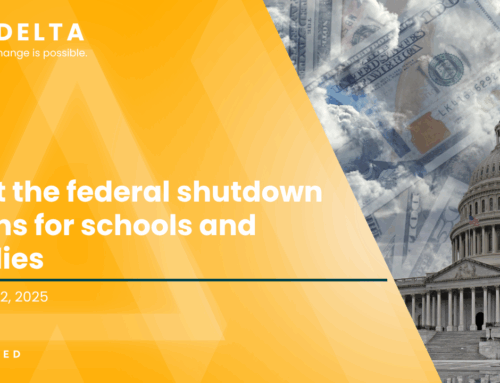The Delta Issue #64
Hunger Doesn’t Wait for Congress.
Hi y’all, Jessica here.
This weekend, 42 million people—including millions of children—woke up without the food assistance they rely on from the Supplemental Nutritional Assistance Program (SNAP).
Hunger doesn’t wait for Congress to compromise; it shows up in schools the very next day. Research shows that when kids come to school hungry, everything gets harder. They struggle to focus, remember, manage their emotions, and even sit still. Their brains and bodies are working on survival, not long division.
Teachers report seeing the effects of food insecurity every day, with students losing focus, struggling to keep up, and missing school because they’re sick.
The bottom line: If we want children to learn, we have to make sure they can eat.
What’s going on
- We’re now more than a month into the longest government shutdown on record, and SNAP is the first child-facing, truly universal safety-net program to hit the cliff. Two federal judges have ordered the Trump administration to continue paying food stamp benefits during the shutdown. But the administration now says it will only send partial SNAP payments this month, covering roughly half of eligible families. Millions are still waiting, new applicants won’t receive benefits at all, and states are bracing for delays and the possibility of another lapse in aid.
- States are trying to cushion the blow. New York declared an emergency and moved $65M for 40 million meals, while Nevada and others are tapping rainy-day or emergency funds. State governments are not equipped to cover SNAP benefits indefinitely. They can feed families for a short period of time, but not without impacting other state services that Americans rely on.
- This is happening at the exact same time Head Start grantees are warning they’ll have to close classrooms, putting more than 65,000 children’s seats at risk, and taking away a place that provides children with two meals a day. On top of this, the Women, Infants, and Children (WIC) Program is running on short-term emergency funds that could run out within weeks. And child care and CACFP providers are watching the calendar, knowing they can’t float missed federal reimbursements forever.
- In other words: we’re not seeing one program wobble; we’re seeing the whole child-serving federal pipeline start to shake.
Ripple effects across programs
A few weeks back, we wrote in The Delta about how quickly federal policy shifts can ripple through early childhood systems. A family that loses SNAP on Saturday will be in the school counselor’s office on Monday. Principals will start asking food service to “just feed anyone who shows up.” Attendance teams will see more kids staying home. A federal budget fight is about to turn into a district and childcare operations problem.
The systems that make sure kids get the nutrition they need—SNAP, school lunches, and child care meal programs are like a complicated Jenga tower. Each piece fits carefully with the others to hold everything in place. But when one piece comes out, like SNAP, it puts pressure on every other block in the stack and makes the whole structure vulnerable to collapse.
States are already starting to rob Peter to pay Paul. Governors are moving money from state reserves and other programs to keep food services open. That helps families in the short term, but it means something else—often another child-serving program—doesn’t get funded.
What states and districts can do right now
None of us know when this shutdown will end—or how many more “firsts” we’ll see in a government already full of unprecedented moments—but one thing is certain: Kids will walk into classrooms hungry.
The good news is that states aren’t powerless. The bad news is that they’ll have to work harder than they should because Washington didn’t do its job.
Here’s where to start:
- Map your pressure points. Where will families in your state go if SNAP doesn’t load: school cafeterias, CBO meal sites, Head Start, child care centers? Make a list and get real about capacity. How many meals can those systems absorb for two or three weeks? Are they staffed, stocked, and ready for a surge? The faster you can identify the stress points, the faster you can move resources to them.
- Lower the barriers. If there’s a way to make free school breakfast and lunch universal, even for a short window, do it. Drop paperwork requirements, simplify eligibility checks, and use existing CEP authority to feed as many kids as possible. The less friction families face, the faster kids eat, and the fewer will show up to class hungry.
- Connect across agencies. If human services is fielding calls from families who can’t buy groceries, K–12 and early childhood leaders need to know which neighborhoods those calls are coming from. That kind of data helps pinpoint where hunger is likely to show up next, and where schools, child care programs, and food sites will need extra support. For more on how to do this, check out our Tracking Potential Impacts resource.
- Document everything. Extra meals, extra hours, extra deliveries. Even if USDA says today it won’t reimburse states or schools, Congress sometimes changes its mind when the stories start piling up.
Let’s get muddy
- NYT: “Which Federal Programs Are Under Scrutiny? The Budget Office Named 2,600 of Them.” Back in January, @The New York Times released a list of 2,600 federal programs under review by the Trump administration. In that list, there are dozens of child-facing programs and dozens more food assistance programs that are in the Trump administration’s crosshairs.
- The 74: Federal Funding Upheaval Is Harmful for Children, Parents, and Educators. This piece makes the emotional and operational case really well: When Washington introduces precarity into programs like Head Start, it’s families and educators who carry the stress.
- Delta: Governors Say Early Learning Is a Priority. Federal Cuts Put That at Risk. This Delta includes a resource with the questions every agency—health, human services, early learning, and K–12—should be asking together to understand where a SNAP lapse will actually land in your state. If you only have time for one thing this week, send it around and have people fill it out together.





